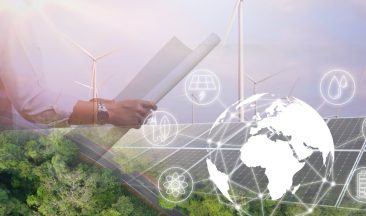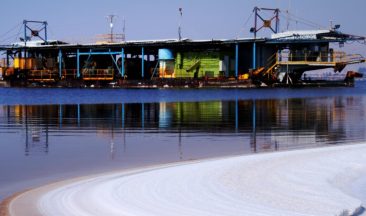Traditional farming has us climbing the walls. We’re losing arable land to soil erosion, salinization, drought, and rising sea levels while converting more and more of what’s left into farms to feed an anticipated world population of 10 billion people not so far in the distant future. Sometimes it looks like a losing battle.
But it can’t be as hopeless as it seems. After all, our ancient ancestors found ways to boost farm yields using the most basic forms of technology: fertilizer, irrigation, terraced farming. Certainly we—with precision agriculture, sustainable agricultural practices, and advances in biotechnology—can come up with a solution to this dilemma.
Indeed, we may have already done so. It’s called vertical farming.
What Is Vertical Farming?
Vertical farming has farmers climbing walls—literally—to produce food on vertically inclined surfaces. The vertical farm is one in which food is grown in trays or other modular structures that can be stacked vertically to conserve space.
Crops are grown in fortified soil, water, or air—yes, air—under controlled environmental conditions under artificial light that can mimic the sun in terms of coaxing plants to undergo photosynthesis.
The “stackability” of its components, make the vertical farm suitable for tall buildings in city spaces, combined with the flexibility of growing food in soil or dirt-free under hydroponic (nutrient-enriched water) or aeroponic (nutrient-rich sprays) conditions make vertical farmers extremely land efficient and water-efficient and less likely to have to do battle against the infestation and diseases associated with soil.
Vertical farmers are proud of their work. They tend to be extremely environmentally friendly while being open to technology that can help them maximize the quality and quantity of their work.
Is Vertical Farming a New Idea?
Vertical farming is not a new idea. Vertical farming has a long history that started between 605-562 BC with the Hanging Gardens of Babylon.
Rice growers in East Asia have used a form of vertical farming–rice terraces–for centuries and with the same as goals are vertical farmers today–to produce more food per acre and put natural resources (sunlight, water, nutrients, etc.) to multiple uses.
Coined by American geologist Gilbert Ellis Baily in 1915, vertical farming grew in popularity along with the popular interest in organic food, optimization of space in urban centers, energy conservation, and compensating for the loss of arable land.
What Are the Advantages of Vertical Farming?
At this point, you may feel that vertical farming has nothing but advantages to offer the world, especially in urban environments and other places where arable soil and other natural resources are compromised or in short supply.
Advantages of vertical farming over traditional methods:
- Space Efficiency: Utilizes vertical space, reducing land use.
- Reduced Water Usage: Uses up to 70-95% less water.
- Year-Round Production: Independent of seasonal changes and weather conditions.
- Higher Yield per Area: Produces more crops per square foot of growing area.
- Reduced Transportation Costs: Can be located closer to urban areas, minimizing transport.
- Pesticide-Free: Controlled environments reduce the need for pesticides.
- Energy Efficiency: Uses LED lighting and renewable energy sources.
- Less Soil Degradation: No soil needed, reducing land degradation.
- Improved Food Security: Provides a reliable food source in urban areas.
- Sustainable Practices: Promotes sustainable agricultural practices.
These advantages suggest that it is well suited to handle any rise in food demands the future may bring.
What Are the Disadvantages of Vertical Farming?
Vertical farming may sound like the best thing since sliced bread, but when is the last time you actually saw one?
Some relatively small companies have set up vertical farms around the world to produce a limited variety of crops for sale in specialized (e.g., gourmet) markets. However, they have yet to see the money and have yet to see the light.
It’s about the money, honey.
Vertical farming greatly depends on technology (to control temperature, lighting, moisture, and other parameters) and advanced horticultural skills. The main disadvantage of vertical farming is, quite frankly, it can be too expensive.
Vertical farms are needed most in urban areas, which suffer from lower quality foodstuffs due to the long distances food has to be shipped from farms.
Unfortunately, real estate and labor costs are considerably high in big cities, as is the cost of maintaining optimal temperature, humidity, and carbon dioxide levels artificially to facilitate healthy plant growth.
The high initial investment and dependence on technology currently hamper the market growth in this area, especially hydroponics, aeroponics, and, eventually, climate control devices.
No bees, no pollination.
Vertical farming relies on indoor, controlled environmental conditions. Under such conditions, there are no bees, butterflies, insects, and other pollinators, thus farmers need to use manual pollination. This process can be labor-intensive and costly.

Let there be light.
The biggest barrier to vertical farming is the cost of artificial illumination, which eats up close to 70% of the cost of vertical farming—far more than the cost of air management, nutrient delivery systems, and plant health monitoring systems.
LEDs
Vertical farmers select light sources that mimic the sun to “trick” plants into undergoing photosynthesis. LED (for light-emitting diode) bulbs are popular because they are “directional”—i.e., they emit light in a specific direction, thereby using light and energy very efficiently.
They are particularly useful down—and up–on the farm, because they produce a variety of colors (including amber, purple, red, green, and blue), indicating the projection of a variety of wavelengths.
This is important because different plants use different regions of the color spectrum during different phases of growth. Lettuce, for example, grows best as it comes out of the ground under blue light and blooms best under red light, whereas plants with carotenoid cells tend to grow better under green light.
LED bulbs fade in brightness over time, but their technology is considered advantageous enough to serve as the basis for a brighter future on the vertical farm. Scientists are exploring organic LEDs (OLEDs) for their usefulness in vertical farming.
Research and Support
The disadvantages of vertical farming are big—particularly the cost of maintaining a controlled environment, –but not insurmountable. The latter is being helped along by the willingness of governmental agencies–including the US Department of Agriculture and the National Institute for Food and Agriculture– partnering with industries to support research opportunities.
The advent of vertical farming for profit is relatively new, but the industry is stepping up to help it along.
Hopes are still high. Vertical farming can help overcome agricultural related sustainability challenges by maximizing crop yields with optimum usage of resources.
You may be interested in:
Top 10 Agriculture Trends to Watch in 2024
Agtech and sustainability
Osmocote – slow release fertilizers
The Future of Vertical Farming
Despite the negative impact of cost and technology, the future looks bright for the vertical farming market. Valued at $3.1 billion in 2021, it is projected to grow to $9.7 billion by 2026.
All eyes are on the Asia-Pacific region, which held a major share of this market in 2020 and is expected to maintain its hold, given the strong interest in organic food in the region and the fact that it consumes more than 75% of the world’s vegetables.
The Covid-19 pandemic pointed to the, sometimes, urgent need for a local, reliable, healthy food supply.
A healthy future in vertical farming strongly depends on our ability to enhance the advantages of vertical farming and overcome its disadvantages. The advantages of vertical farming are clear: higher crop yields, fresh, nutritious, tasty vegetables grown year-round by caring farmers under controlled conditions with optimal usage of resources.
ICL is dedicated to advancing food security through a broad array of AgTech solutions, fertilizers, and other innovative products that reduce food waste, enhance crop yields and quality, and facilitate fertilizer uptake to increase nutrient use efficiency while reducing crop water consumption.
We are also teaching farmers around the world how to assess food loss and waste in order to enhance their food supply while monitoring factors that influence biodiversity.
The future of vertical farming, thus, depends on our willingness to support ongoing research—and, of course, to support the farmers at the forefront of this movement by purchasing as much of their produce as possible.







